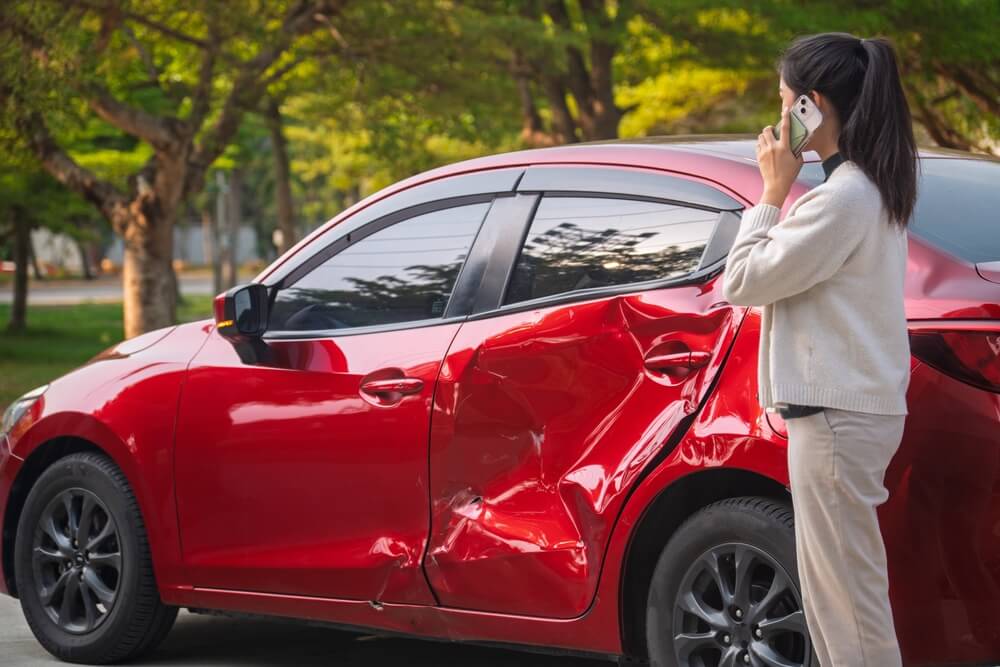Get the Best
Third-Party Liability Coverage
for Your Vehicle
Compare and save an average of $800* on Ontario car insurance with RATESDOTCA.
Compare third-party liability car insurance quotes from top providers
Jump straight to:
- What is third-party liability insurance?
- Why do I need third-party liability car insurance?
- What does third-party liability insurance cover?
- Third-party liability car insurance requirements across Canada
- Physical damage covered by third-party liability
- How much third-party liability insurance coverage do I need?
- Most recent third-party liability car insurance quotes
- How to get a third-party liability car insurance quote on RATESDOTCA
- How to get the cheapest third-party liability insurance
- How do third-party liability car insurance claims work?
- Frequently asked questions about third-party liability car insurance
What is third-party liability insurance?
Third-party liability car insurance covers losses incurred due to your actions. This includes damage to someone else's property, bodily injury or death.
Why do I need third-party liability car insurance?
If you are involved in a car accident and found to be partially or totally at fault, third-party damages can be costly. Being at fault makes you liable for damages suffered by other people, including injuries and property damage. Third-party liability car insurance covers bodily injury, property damage, and any legal expenses you may incur.
Most importantly, third-party car insurance is mandatory across all provinces in Canada. You must have it to drive a car legally.
What does third-party liability insurance cover?
Standard third-party liability covers:
- Medical bills in case of injuries to a third party (including pedestrians, cyclists, and fatalities)
- Repair costs to any damaged vehicles
- Repairs or replacement of damaged property
- Legal fees and lawsuits
- Damages awarded to the injured parties
What doesn’t third-party liability insurance cover?
It won't cover damage to your vehicle when you are at fault. However, insurance is available for this scenario in the form of collision coverage — but you have to pay extra.
Third-party liability also won't help pay for any injuries you sustain. Instead, the accident benefits portion of your policy covers this. Accident benefits are already part of most provinces' standard auto insurance policies.
Third-party liability car insurance requirements across Canada
| Province/territory | TPL requirements | Details |
|---|---|---|
| British Columbia | $200,000 min | Payment for property damage capped at $20,000 |
| Manitoba | $200,000 min | Payment for property damage capped at $20,000 |
| New Brunswick | $200,000 min | Payment for property damage capped at $20,000 |
| Newfoundland | $200,000 min | Payment for property damage capped at $20,000 |
| Nova Scotia | $500,000 min | N/A |
| Northwest Territories | $200,000 min | Payment for property damage capped at $10,000 |
| Nunavut | $200,000 min | Payment for property damage capped at $10,000 |
| PEI | $200,000 min | Payment for property damage capped at $10,000 |
| Quebec | $50,000 min | N/A |
| Saskatchewan | $200,000 min | Payment for property damage capped at $10,000 |
| Yukon | $200,000 min | Payment for property damage capped at $10,000 |
| Alberta | $200,000 min | If a claim for damages exceeds this amount, payment for property damage is capped at $10,000. |
| Ontario | $200,000 min | If a claim for damages exceeds this amount, payment for damages will be capped at $10,000 and DCPD applies. |
Physical damage covered by third-party liability
Third-party liability insurance policy offers protection against the expenses associated with damage or injury suffered by someone other than yourself. Some examples of accidents a third-party liability car insurance policy will cover are:
- Knocking over a neighbour’s fence while reversing your vehicle.
- Hitting a cyclist or pedestrian with your vehicle and injuring them.
- Losing control of your car due to weather conditions and damaging someone’s property.
- Damaging someone’s car in a collision you caused.
- Injuring the driver of another car in a collision you caused.
How much third-party liability insurance coverage do I need?
Most provinces (except Nova Scotia and Quebec) have a minimum third-party liability insurance requirement of $200,000. Therefore, any adequately insured driver will be insured for the minimum.
However, the cost of liabilities often exceeds $200,000. That's why drivers are recommended to opt for the $1 to $2 million range of coverage. It provides a more significant safety net for unforeseen circumstances and cushions any financial hardship you may incur if your basic coverage is limited.
Third-party liability is mandatory in all provinces, although minimum coverages may vary. There's no circumstance in which liability coverage isn't needed. As a driver, you must protect yourself from liability in all cases should an accident occur.
Most recent third-party liability quotes

Recent auto Insurance Quote from North york, Ontario
Male, 31 years old
2025 TOYOTA COROLLA CROSS LE 4DR AWD
July 22, 2025
Cheapest Quote
$ 517 / month
$ 6,202 / yearAverage Quote
$ 819 / month
$ 9,829 / yearSavings
$ 302 / month
$ 3,627 / year
37 %
Recent auto Insurance Quote from Pickering, Ontario
Female, 67 years old
2017 LEXUS RX350 4DR 2WD
July 22, 2025
Cheapest Quote
$ 122 / month
$ 1,464 / yearAverage Quote
$ 178 / month
$ 2,134 / yearSavings
$ 56 / month
$ 670 / year
31 %
Recent auto Insurance Quote from Scarborough, Ontario
Male, 39 years old
2016 HONDA CIVIC DX 4DR
July 22, 2025
Cheapest Quote
$ 581 / month
$ 6,969 / yearAverage Quote
$ 789 / month
$ 9,462 / yearSavings
$ 208 / month
$ 2,493 / year
26 %
What people say about our quotes

Based on 6,450 reviews

Fast efficient and fair
Quick quotes. Great rates. Easy to process
Trinity

Comparing Travel Insurance …
This was the only site I could find that allowed me to compare different travel insurance options. I particularly liked the ability to look at sample documents.
Toronto

Amazing
Very helpful and easy to use
Safe travels

Easy quick selection of rates
Easy quick selection of rates
J K

Great help in finding the best rate!
Great help in finding the best rate! Thanks a lot!
Ruthielyn opina

I like how I can quickly I can select…
I like how I can quickly I can select travel insurance. The web site had an issue earlier but seemed to correct itself.
Dennis
How to get a third-party liability car insurance quote on RATESDOTCA
Tell us about your vehicle
Answer a few basic questions about your driving & car insurance history.
Compare your quotes
See quotes from insurance companies side by side.
Choose the right coverage
Find the right protection for your vehicle.
Get covered
Connect with the provider and secure your rate.
How to get the cheapest third-party liability insurance
There are a lot of tactics you can use to lower your car insurance premiums, but some make more of a difference than others. Here are the most impactful moves you can make to lower your rate.
Buy a cheaper car
The vehicle you choose has an outsized impact on how much you pay for insurance. It's almost as consequential as driver behaviour.
First, choose a car that's less likely to be stolen. The Insurance Bureau of Canada publishes a list annually of the most frequently stolen cars. While thieves often target luxury car brands like Lexus, middle-of-the-road brands like Toyota and Ford make up a significant portion of thefts.
Also, remember that a fully optioned car will cost more to repair or replace and, therefore, to insure. On the other hand, a vehicle with a basic trim will have lower potential claims costs and will be less expensive to insure.
Lastly, avoid financing a car. Loan providers and lessors make you purchase comprehensive insurance coverage for the vehicle. It ensures the lender doesn't lose their investment if you default on your loan.
Keep a clean driving and insurance record
This tip doesn't result in immediate savings, but it's up there with buying a cheaper car to keep your premiums low.
Don't rack up traffic tickets, avoid making insurance claims, and always pay your premium on time. Suppose you can maintain a spotless continuous insurance history over the years. In that case, insurance companies will eventually offer you their preferred (lowest) rates.
To protect your reputation as a great driver, consider purchasing an endorsement that covers you from a rate increase on your first at-fault accident. A reputation for good driving behaviour takes time and effort to establish. Still, it will significantly impact your insurance rates in the long run.
Pass on optional coverages
Your car loses value over time. At some point, your car will depreciate to the point where it would be cheaper to replace rather than continue paying for collision and comprehensive insurance. Vehicles five years old or more typically don't need collision or comprehensive insurance.
Increase your deductible
The deductible is how much you agree to pay out of pocket for damages before your insurance company pays out your benefit. If you offer to shoulder more of the expense, your insurance company will lower your premium.
Try usage-based insurance
If you drive 12,000 kilometres a year or less, consider getting a usage-based insurance policy. When you apply for a car insurance policy, insurance companies ask you to predict the number of kilometres you expect to log over the coming year. This leads some people to inflate the number to stay on the safe side. A usage-based policy offers more flexibility than a traditional policy. You pay for every 1,000 kilometres you drive, usually up to 12,000 kilometres. Essentially, you err on the side of being a low-mileage driver, reap a cheaper premium, and pay the difference on the off chance you go over your allotment of kilometres.
Sign up for telematics
Telematics refers to insurance technology that monitors your driving habits. Insurance companies give you a compact sensor you install in your car and pair it with an app.
Together, the devices can monitor your speed, how hard you brake, and the distance travelled. If the device reflects cautious driving habits, you'll receive a discount at renewal — up to 20% in some cases. Some insurance companies offer an initial discount for enrolling in the program.
Telematics programs are available in Ontario, Nova Scotia, New Brunswick, Quebec, and Alberta. One word of caution: insurance companies can use the information to raise your rates in Ontario.
Compare rates
Be sure to compare rates. Car insurance companies in provinces with private insurance markets don't charge the same for coverage. The price of your car insurance depends on the insurer you choose. In 2021, RATESDOTCA drivers saved an average of $772 and $736 annually in Ontario and Alberta, respectively. Both the Auto Insurance Rate Board of Alberta and the Financial Services Regulatory Authority of Ontario recommend shopping around to find a lower rate.
However, be wary of switching insurance companies midway through your term, as this will likely result in a premium increase. Waiting until your renewal period is recommended to avoid cancellation penalties.
Other tactics worth trying:
- Pay for your annual coverage upfront.
- Reduce your dependency on your car: the more kilometres you log, the more you'll pay for insurance, so try to incorporate other modes of transportation into your lifestyle, like walking, biking and public transit.
- Take a ministry-approved driver training program. Check with your insurance provider about courses that could earn you a discount on your coverage.
- Apply for as many discounts as you can. Examples of typical insurance discounts include:
- Winter tire discount
- Alumni and employer discounts
- Savings for students who maintain a certain GPA
- Bundling discount (insure multiple cars with the same provider or combine home and auto)
How do third-party liability car insurance claims work?
If you were at fault for an accident and caused injury or property damage to a third party, your insurer will review the costs to compensate them and offer a settlement. The third party can agree to the terms, seek legal advice or file a lawsuit. Your insurance will cover expenses up to your policy limit.
In provinces with no-fault insurance systems, everyone involved will deal with their insurance provider for any claims. You won't need to communicate with the third party's insurance company.
Frequently asked questions about third-party liability car insurance
Have more questions about third-party liability insurance? We’ve got answers.
How can I find the cheapest third-party liability car insurance?
One of the best ways to find the cheapest third-party liability car insurance coverage is through comparison sites like RATESDOTCA. With a few clicks and some information about your driving needs, we can provide quick quote comparisons to ensure you can choose the cheapest rates available.
Which company has the cheapest third-party liability car insurance in Canada?
The price you pay for third-party liability car insurance in Canada will depend on many variables. These include where you live, how much you drive, your province's mandatory requirements and more.
By comparing rates on sites like RATESDOTCA, you’ll see a comparison of quotes from which you can choose. Comparison shopping on RATESDOTCA provides fast and accurate information and ensures you pay the cheapest amount for the coverage you need.
Do I need third-party liability insurance to rent a car?
The first thing to do when renting a car (or even before) is to speak with your provider. Your own insurance policy may include liability for rental car insurance, which transfers all your existing coverage to a rental car. However, suppose you don't have car insurance. In that case, third-party liability is an essential and money-saving addition to your rental agreement if you injure someone or damage their property.
*Shoppers in Ontario who obtained an auto insurance quote on RATESDOTCA and transacted via our contact centre from January to December 2022 saved an average amount of $800. The average savings amount represents the difference between the shoppers’ average lowest quoted premium and the average of the second and third lowest quoted premiums generated by RATESDOTCA.











